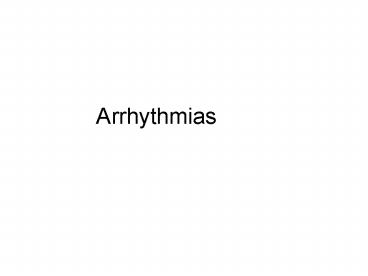Arrhythmias - PowerPoint PPT Presentation
1 / 22
Title:
Arrhythmias
Description:
Treated with atropine, beta agonists, or pacemaker if symptomatic ... Atropine. Beta agonists. Drug antidotes. Bradyarrhythmias, cont... Heart block ... – PowerPoint PPT presentation
Number of Views:54
Avg rating:3.0/5.0
Title: Arrhythmias
1
Arrhythmias
2
Definitions
- Arrhythmias abnormalities of the heart rate or
the heart rhythm - Tachycardia is a HR gt100
- Increased pacemaker activity faster
depolarization, lower thresholds, or oscillations
during repolarization trigger early action
potentials - Re-entry circuits depolarization travels in a
circleif tissue is not refractory when the
impulse returns, it will depolarize again
producing a recurring circuit - Bradycardia
- HR lt60
- Due to abnormal and/or delayed conduction
3
General Management
- Prevention
- Early correction of
- Hypoxemia
- Electrolyte imbalances
- Acid-base imbalances
- Cardiac ischemia
- Arrhythmogenic factors
- Pain
- Vagal stimulation
- Drugs
- Cardiac irritants
4
General Management, cont
- Tachyarrhythmias
- Detrimental when they cause symptoms or reduce
tissue perfusion - Must be terminated immediately if they cause
hypotension, pulmonary edema, or angina - Bradyarrhythmias
- Treated with atropine, beta agonists, or
pacemaker if symptomatic - Not all will require treatmentif the person is
stable and asymptomatic you can treat the cause
without converting the rhythm
5
General Management, cont
- Vagal stimulation
- Carotid sinus massage
- Slows HR and may cardiovert some SVTs
- Antiarrhythmic drugs
- Selected according to the rhythm and the
underlying pathophysiology - Therapeutic windows are often narrow
- Side effects are common
- Therapy is frequently ineffective
- They may cause other arrhythmias
- Arrhythmia suppression does not always improve
outcomes
6
General Management, cont
- Non-pharmacologic therapies
- DC cardioversion
- Uses 50-360 joule shocks
- Timed to deliver on the QRS
- Defibrillation
- Uses 50-360 joule shocks
- Not timed
- May be external or implanted
- Radiofrequency catheter ablation (RFCA)
- Heat is delivered through a catheter to a
specific site in the heart
7
(No Transcript)
8
Diagnosis
- Not always easy because artifact can interfere
with the EKG tracings - Narrow QRS complex tachycardias
- Usually due to SVT
- Can be terminated with IV adenosine
- Wide QRS complex tachycardias
- Usually due to V tach, but could also be SVT with
abnormal conduction - Treat as if it were VT (cardioversion/lidocaine)i
f no response, then try adenosine
9
Tachyarrhythmias
- Supraventricular tachycardias
- Orginate above the AV node
- Present with dizziness, palpitations, dyspnea
- Are not usually life-threatening
- Types
- Sinus tachycardia
- a normal response to stress, exercise, hypoxemia,
fever, increased sympathetic tone - Treat by removing the cause
- Atrial tachycardia
- due to ectopic atrial automaticity in chronic
heart/lung dx - associated with metabolic, acid-base, or drug
toxicity - Treat by correcting the underlying metabolic
defect or with RFCA
10
(No Transcript)
11
Tachyarrhythmias, cont
- Atrial flutter
- A re-entry tachycardia involving the whole atrium
- Atrial rate is 300/min
- Ventricular rate depends on AV conduction
- Treated with digoxin
- Atrial fibrillation
- Multiple re-entry circuits with chaotic atrial
rhythm - Atrial rate is 500/min
- Ventricular rate depends on AV condutionconsidere
d controlled as long as ventricular rate lt100 - Stasis of blood from ineffective contraction
predisposes to thrombus formation - Treat with digoxin, anticoagulants, cardioversion
- Re-entry tachycardia
- Re-entry circuits via many AV node conduction
pathways - Responds to vagal stimulation and drugs that slow
AV conduction, such as adenosine
12
(No Transcript)
13
Tachyarrhythmias, cont
- Ventricular tachycardias
- Arise in the ventricles of patients with heart
dx, cardiomyopathy, or congential heart dx - Generally more serious than atrial tachs
- Types
- Ventricular tachycardia
- Usually caused by re-entry circuits that form
with scarring but can be ectopic automaticity - Usually causes hemodynamic decompensation
- Ventricular rate 150-250
- Treat with cardioversion or drugs to suppress the
rhythm
14
(No Transcript)
15
Tachyarrhythmias, cont
- Ventricular fibrillation
- Chaotic ventricular rhythm that frequently
follows an acute MI - Immediate loss of CO with unconsciousness
- Treat with defibrillationthe sooner the better
- May use drugs to prevent recurrence or
implantable defibrillator
16
Bradyarrhythmias
- Well tolerated by normal hearts, but CO and BP
will fall if SV cant increase - Types
- Sinus bradycardia
- Normal EKG with rate lt60
- Causes
- vagal reflexes (pain, hypoxemia)
- Drug toxicity (beta blockers, digoxin)
- AV node ischemia
- Treatment
- Atropine
- Beta agonists
- Drug antidotes
17
(No Transcript)
18
Bradyarrhythmias, cont
- Heart block
- Usually due to ischemic damage to nodal or
conducting tissue - Common after an inferior MI b/c right coronary
artery supplies the AV node in most people - Presence after an anterior MI suggests a large
infarction - First degree
- slow AV conductionPR interval exceeds 0.2
seconds - Usually benign
- Second degree
- Some atrial beats are not conducted to the
ventricles
19
Bradyarrhythmias, cont
- Types of second degree heart block
- Mobitz I (Wenckebach)
- Causes PR interval to lengthen with each beat,
culminating in the failure of an atrial impulse
to be transmitted to the ventricle (dropped beat) - Sequence is repetitive
- Treatment is usually not needed
- Mobitz II
- Originates below the AV node in the bundle of HIS
or Purkinje fibers - Every 2nd or 3rd atrial impulse initiates a
ventricular contractionthe others are blocked - May require pacemaker insertion
20
(No Transcript)
21
Bradyarrhythmias, cont
- Third degree heart block (complete heart block)
- Conduction between the atria and ventricles
ceases - The atria contract at one ratethe ventricles
contract at another rate (usually 20-40) - Requires pacemaker insertion
22
(No Transcript)































